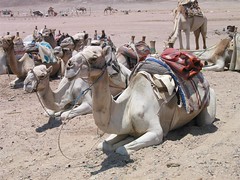A fully-grown adult camel stands 6 feet at the shoulder and 7 feet at the hump, says wikipedia.org. The hump rises about 30 inches out of its body. Camels can run up to 40mph in short bursts, and sustain speeds of up to 25mph.
Humans first domesticated camels between 3,500–3,000 years ago. The dromedary and the Bactrian camel are both still used for milk , meat, and as beasts of burden—the dromedary in western Asia, and the Bactrian camel further to the north and east in central Asia.
Camels are well known for their humps. However, they do not store water in them as is commonly believed, though they do serve this purpose through roundabout means. Their humps are actually a reservoir of fatty tissue. When this tissue is metabolized, it is not only a source of energy, but yields through reaction with oxygen from the air. This process of fat metabolization generates a net loss of water through respiration.
Their ability to withstand long periods without water is due to a series of physiological adaptations, as described below.
They have tough feet so that they can endure the scorching desert sands.
Their red blood cells have an oval shape, unlike those of other mammals, which are circular. This is to facilitate their flow in a dehydrated state. These cells are also more stable[2], in order to withstand high osmotic variation without rupturing, when drinking large amounts of water (20-25 gallons[citation needed] in one drink).
The kidneys of a camel are very efficient. Urine comes out as a thick syrup and their feces are so dry that they can fuel fires.
Camels are able to withstand changes in body temperature and water content that would kill most other animals. Their temperature ranges from 34°C (93°F) at night up to 41°C (106°F) at day, and only above this threshold will they begin to sweat. The upper body temperature range is often not reached during the day in milder climatic conditions and therefore the camel may not sweat at all during the day. Evaporation of their sweat takes place at the skin level not at the surface of their coat, thereby being very efficient at cooling the body compared to the amount of water lost through sweating. This ability to fluctuate body temperature and the efficiency of their sweating allows them to preserve about five litres of water a day.
A feature of their nostrils is that a large amount of water vapor in their exhalations is trapped and returned to the camels body fluids, thereby reducing the amount of water lost through respiration.
They can withstand at least 20-25% weight loss due to sweating (most mammals can only withstand about 3-4% dehydration before cardiac failure results from the thickened blood). A camel's blood remains hydrated even though the body fluids are lost; until this 25% limit is reached.
Camels eating green herbage can ingest sufficient moisture in milder conditions to maintain their body's hydrated state without the need for drinking.
A camel's thick coat reflects sunlight. It also insulates them from the intense heat that radiates from hot desert sand. Their long legs help by keeping them further from the hot ground. Camels have been known to swim if given the chance.
Their mouth is very sturdy, able to chew thorny desert plants. Long eyelashes and ear hairs, together with sealable nostrils, form an effective barrier against sand. Their gait (moving both legs on one side at the same time) and their widened feet help them move without sinking into the sand.
Wednesday, October 17, 2007
Subscribe to:
Post Comments (Atom)


No comments:
Post a Comment